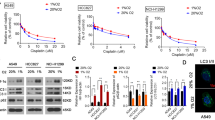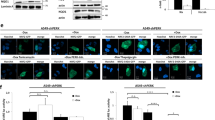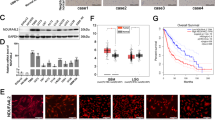Abstract
Therapy targeting hypoxia-inducible factor-1 (HIF-1) to reverse the hypoxia-related drug resistance has received much interest. Despite a close interaction between HIF-1 and p53 and that p53 mutation is seen in >50% of tumors, whether HIF-1 silencing by targeted therapy depends on tumor p53 status remains unknown. Two isogenic fibrosarcoma cells HT1080 (wild-type p53) and HT1080-6TG (mutant p53) were transduced with HIF-1α-specific RNAi lentiviral vectors and selected with blasticidin. Real-time PCR and western blot analysis of HIF-1α mRNA and protein respectively validated the silencing effects. Cells were first preconditioned under hypoxia (0.5% O2) for 4 h and then co-treated with cisplatin for another 24 h. MTT was used for assessment of chemosensitivity to cisplatin. Moreover, annexin V and propidium iodide staining was detected on flow cytometry for analysis of cisplatin-induced apoptosis. Furthermore, changes of some Bcl-2 family members were detected on western blotting. Exposure to hypoxia significantly increased resistance to cisplatin than exposure to normoxia. HIF-1α knockdown could reverse hypoxia-related resistance to cisplatin and apoptotic resistance only in HT1080 cells, but had little effect on HT1080-6TG cells. With HIF-1α knockdown, Bid expression was higher in HT1080 than in HT1080-6TG under hypoxia. In summary, HIF-1 targeted therapy to reverse hypoxia-related cisplatin resistance depends on normal p53 status. Changes of Bid expression levels under hypoxia might contribute in part to the differential response to HIF-1α silencing in cells with different p53 status.
This is a preview of subscription content, access via your institution
Access options
Subscribe to this journal
Receive 12 print issues and online access
$259.00 per year
only $21.58 per issue
Buy this article
- Purchase on Springer Link
- Instant access to full article PDF
Prices may be subject to local taxes which are calculated during checkout




Similar content being viewed by others
Accession codes
References
Glaccia A, Siim BG, Johnson RS . HIF-1 as a target for drug development. Nat Rev Drug Discov 2003; 2: 803–811.
Semenza GL . Targeting HIF-1 for cancer therapy. Nat Rev Cancer 2003; 3: 721–732.
Brown LM, Cowen RL, Debray C, Eustace A, Erler JT, Sheppard FC et al. Reversing hypoxic cell chemoresistance in vitro using genetic and small molecule approaches targeting hypoxia inducible factor-1. Mol Pharmacol 2006; 69: 411–418.
Song X, Liu X, Chi W, Liu Y, Wei L, Wang X et al. Hypoxia-induced resistance to cisplatin and doxorubicin in non-small cell lung cancer is inhibited by silencing of HIF-1alpha gene. Cancer Chemother Pharmacol 2006; 58: 776–784.
Palayoor ST, Burgos MA, Shoaibi A, Tofilon PJ, Coleman CN . Effect of radiation and ibuprogen on normoxic renal carcinoma cells overexpressing hypoxia-inducible factors by loss of von Hippel–Lindau tumor suppressor gene function. Clin Cancer Res 2004; 10: 4158–4164.
Unruh A, Ressel A, Mohamed HG, Johnson RS, Nadrowitz R, Richter E et al. The hypoxia-inducible factor-1α is a negative factor for tumor therapy. Oncogene 2003; 22: 3213–3220.
Arvold ND, Guha N, Wang DF, Matli M, Deen DF, Warren RS et al. Hypoxia induced radioresistane is independent of hypoxia-inducible factor-1A in vitro. Int J Radiat Oncol Biol Phys 2005; 6291: 207–212.
Zhang XW, Kon T, Wang H, Li F, Huang Q, Rabbani ZN et al. Enhancement of hypoxia-induced tumor cell death in vitro and radiation therapy in vivo by use of small interfering RNA targeted to hypoxia-inducible factor-1α. Cancer Res 2004; 64: 8139–8142.
Moller BJ, Dreher MR, Rabbani ZN, Schroeder T, Cao Y, Li CY et al. Pleiotropic effects of HIF-1 blockade on tumor radiosensitivity. Cancer Cell 2005; 8: 99–110.
Piret JP, Cosse JP, Ninane N, Raes M, Michiels C . Hypoxia protects HepG2 cells against etoposide-induced apoptosis via a HIF-1-independent pathway. Exp Cell Res 2006; 312: 2908–2920.
Chen DL, Li MY, Luo JY, Gu W . Direct interactions between HIF-1and Mdm2 modulate p53 function. J Biol Chem 2003; 178: 12595–12598.
Schimid T, Zhou J, Brune B . HIF-1 and p53: communication of transcription factors under hypoxia. J Cell Mol Med 2004; 8: 423–431.
Hammond EM, Glaccia AJ . Hypoxia-inducible factor-1 and p53: friends, acquaintances, or strangers? Clin Cancer Res 2006; 12: 5007–5008.
Fels DR, Koumenis C . HIF-1a and p53: the odd couple? Trends Biochem Sci 2005; 30: 426–429.
Blagosklonny MV, An WG, Romanova LY, Trepel J, Fojo T, Neckers L . p53 inhibits hypoxia-inducible factor-stimulated transcription. J Biol Chem 1998; 273: 11995–11998.
Kaluzova M, Kaluz S, Lerman MI, Stanbridge EJ . DNA damage is a prerequisite for p53-mediated proteasomal degradation of HIF1a in hypoxic cells and downregulation of the hypoixa marker carbonic anhydrace IX. Mol Cell Biol 2004; 24: 5757–5766.
Kamat CD, Green DE, Warnke L, Thorpe JE, Ceriello A, Ihnat MA . Mutant p53 facilitates pro-angiogenic, hyperperoliferative phenotype in response to chronic relative hypoxia. Cancer Lett 2007; 249: 209–219.
Suzuki H, Tomida A, Tsuruo T . Dephosphorylated hypoxia-inducible factor 1alpha as a mediator of p53-dependent apoptosis during hypoxia. Oncogene 2001; 22: 5779–5788.
An WG, Kanekal M, Simon MC, Maltepe E, Blagosklonny MV, Neckers LM . Stabilization of wild-type p53 by hypoxia-inducible factor 1alpha. Nature 1998; 392: 405–408.
Hammond EM, Denko NC, Dorie MJ, Abraham RT, Giaccia AJ . Hypoxia links ATR and p53 through replication arrest. Mol Cell Biol 2002; 22: 1834–1843.
Moller BJ, Dreher MR, Rabbani ZN, Schroeder T, Cao Y, Li CY et al. Pleiotropic effects of HIF-1 blockade on tumor radiosensitivity. Cancer Cell 2005; 8: 99–110.
Zhong H, De Marzo AM, Laughner E, Lim M, Hilton DA, Zagzag D et al. Overexpression of hypoxia-inducible factor 1alpha in common human cancers and their metastases. Cancer Res 1999; 59: 5830–5836.
Hainaut P, Hernandez T, Robinson A, Rodriguez-Tome P, Flores T, Hollstein M et al. IARC database of p53 gene mutations in human tumors and cell lines: updated compilation, revised formats and new visualisation tools. Nucleic Acids Res 1998; 26: 205–213.
Sumiyoshi Y, Kakeiji Y, Egashira A, Mizokami K, Orita H, Maehara Y . Overexpression of hypoxia-inducible factor 1a and p53 is a marker for unfavorable prognosis in gastric cancer. Clin Cancer Res 2006; 12: 512–517.
Theodoropoulos VE, Lazaris AC, Kastriotis I, Spiliadi C, Theodoropoulos GE, Tsoukala V et al. Evaluation of hypoxia-inducible factor 1alpha overexpression as a predictor of tumour recurrence and progression in superficial urothelial bladder carcinoma. BJU Int 2005; 95: 425–431.
Liu JY, Shibata T, Qu RJ, Ogura M, Hiraoka M . Influence of the p53 status on hypoxia-induced gene expression. J Radiat Res 2004; 45: 333–339.
Gonzalez VM, Fuertes MA, Alonso C, Perez JM . Is cisplatin-induced cell death always produced by apoptosis? Mol Pharmacol 2001; 59: 657–663.
Wang J, Biju MP, Wang M, Haase VH, Dong Z . Cytoprotective effects of hypoxia against cisplatin-induced tubular cell apoptosis: involvement of mitochondrial inhibition and p53 suppression. J Am Soc Nephrol 2006; 17: 1875–1885.
Shannon AM, Bouchier-Hayes DJ, Condron CM, Toomey D . Tumor hypoxia, chemotherapeutic resistance and hypoxia-related therapies. Cancer Treat Rev 2003; 29: 297–307.
Li J, Shi M, Cao Y, Pang T, Li B, Sun Z et al. Knockdown of hypoxia-inducible factor-1alpha in breast carcinoma MCF-7 cells results in reduced tumor growth and increased sensitivity to methotrexate. Biochem Biophys Res Commun 2006; 342: 1341–1351.
Chang Q, Qin R, Huang T, Gao J, Feng Y . Effect of antisense hypoxia-inducible factor 1alpha on progression, metastasis, and chemosensitivity of pancreatic cancer. Pancreas 2006; 32: 297–305.
Li L, Lin X, Staver M, Shoemaker A, Semizarov D, Fesik SW et al. Evaluating hypoxia-inducible factor-1alpha as a cancer therapeutic target via inducible RNA interference in vivo. Cancer Res 2005; 65: 7249–7258.
Sasabe E, Zhou X, Li D, Oku N, Yamamoto T, Osaki T . The involvement of hypoxia-inducible factor-1alpha in the susceptibility to gamma-rays and chemotherapeutic drugs of oral squamous cell carcinoma cells. Int J Cancer 2007; 120: 268–277.
Erler JT, Cawthorne CJ, Williams KJ, Koritzinsky M, Wouters BG, Wilson C et al. Hypoxia-mediated down-regulation of bid and bax in tumors occurs via hypoxia-inducible factor1-dependent and independent mechanisms and contributes to drug resistance. Mol Cell Biol 2004; 24: 2675–2889.
kilic M, Kasperczyk H, Fulda S, Debatin K-M . Role of hypoxia-inducible factor-1 alpha in modulation of apoptosis resistance. Oncogene 2007; 26: 2027–2038.
Wang Y, Pakunlu RL, Tsao W, Pozharov V, Minko T . Bimodal effect of hypoxia in cancer: role of hypoxia inducible factor in apoptosis. Mol Pharm 2003; 1: 156–165.
Greijer AE, Van Der Wall E . The role of hypoxia inducible factor 1(HIF-1) in hypoxia induced apoptosis. J Clin Pathol 2004; 57: 1009–1014.
Sax JK, Fei P, Murphy ME, Bernhard E, Korsmeyer SJ, El-Deiry WS . BID regulation by p53 contributes to chemosensitivity. Nat Cell Biol 2002; 4: 842–849.
Acknowledgements
This work was supported by grants from Shandong Province Science Foundation (Q2006C13).
Author information
Authors and Affiliations
Corresponding author
Rights and permissions
About this article
Cite this article
Hao, J., Song, X., Song, B. et al. Effects of lentivirus-mediated HIF-1α knockdown on hypoxia-related cisplatin resistance and their dependence on p53 status in fibrosarcoma cells. Cancer Gene Ther 15, 449–455 (2008). https://doi.org/10.1038/cgt.2008.4
Received:
Revised:
Accepted:
Published:
Issue Date:
DOI: https://doi.org/10.1038/cgt.2008.4
Keywords
This article is cited by
-
Hypoxia Induces the Acquisition of Cancer Stem-like Phenotype Via Upregulation and Activation of Signal Transducer and Activator of Transcription-3 (STAT3) in MDA-MB-231, a Triple Negative Breast Cancer Cell Line
Cancer Microenvironment (2018)
-
The radiosensitising effect of gemcitabine and its main metabolite dFdU under low oxygen conditions is in vitro not dependent on functional HIF-1 protein
BMC Cancer (2014)
-
Targeting the translational apparatus to improve leukemia therapy: roles of the PI3K/PTEN/Akt/mTOR pathway
Leukemia (2011)
-
Role of hypoxia-inducible transcription factor 1α for progression and chemosensitivity of murine hepatocellular carcinoma
Journal of Molecular Medicine (2010)
-
Contribution of HIF-1 and drug penetrance to oxaliplatin resistance in hypoxic colorectal cancer cells
British Journal of Cancer (2009)



